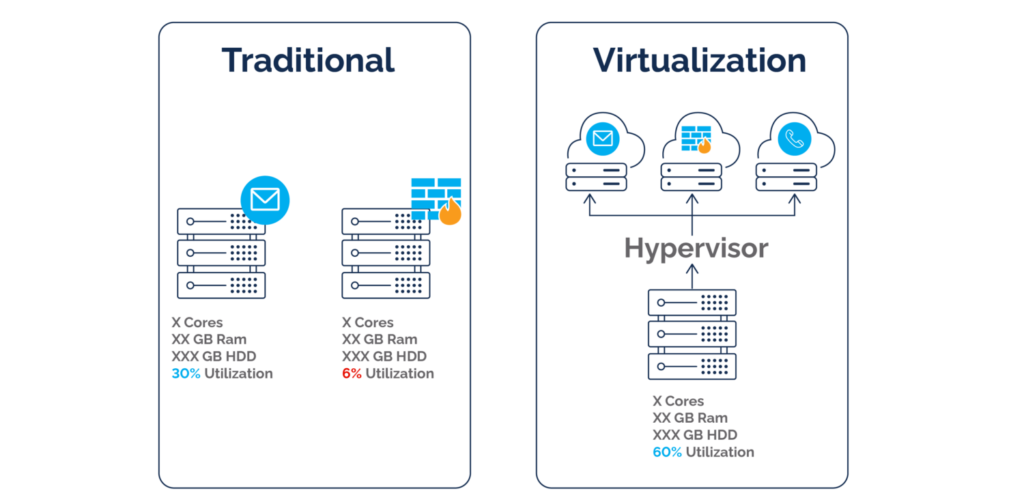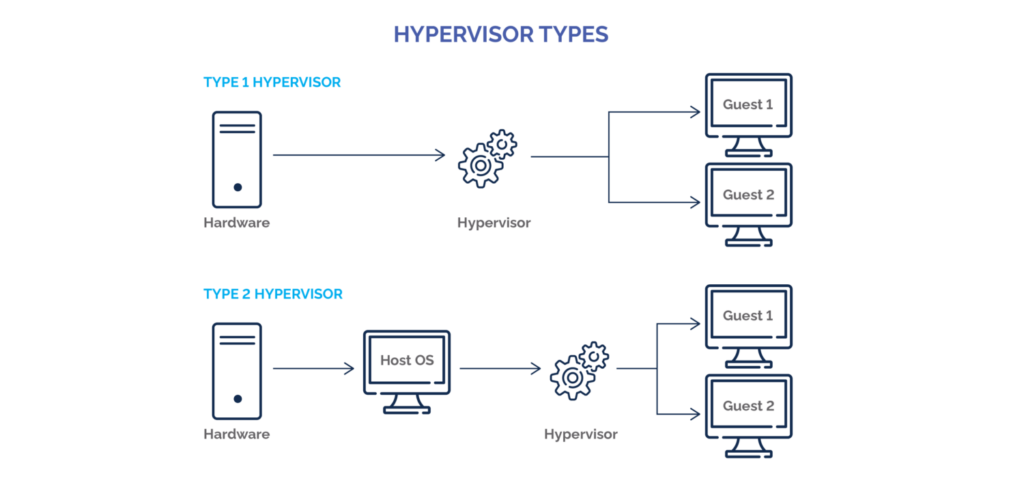Discount up to 35% for first purchase only this month.
A hypervisor is a type of software or hardware used to create virtual machines and then run those virtual machines day to day. You’ll sometimes see the same technology referred to as a ‘virtual machine monitor,’ or VMM, which is a reasonable encapsulation of what a hypervisor does.

f that definition isn’t intuitive for you, allow us to take one step back. To understand what a hypervisor is, you must know about virtual machines, an advance on physical servers. Think back to the early days of computing. In that era, each physical server could only have one operating system. There was no partitioning and workloads affected each other. It was a fine way to do things, but limited.
Enter virtualization. This technology allows multiple virtual machines to run on one server. Now, a single piece of equipment in the physical world can actually look and act like multiple independent servers in the virtual world. (We’ll get to the advantages of a virtualization environment in a moment.)
A hypervisor might be hardware, or it could be a program to manage virtual machines, whether software or firmware. What makes a hypervisor a hypervisor is what it’s used for—it creates, monitors, and manages virtual machines.
The hypervisor is the boss of virtual machines, which we’ll call VMs from here on. The hypervisor allocates resources to VMs or, in other words, manages the physical resources, such as CPU, memory, and storage, that execute functions in the VM environments.
It’s a bit like entering The Matrix. In this metaphor, Neo’s body is the physical hardware. It can operate in the real world as a single, physical server or his mind (still reliant on his physical brain) can go virtual. The interface that enables Tank, ‘the operator,’ to simultaneously monitor and manage the different, individual experiences of all the humans on his ship who are plugged into the Matrix—that’s akin to the hypervisor.
It is possible to have VMs without a hypervisor. Such virtualization typically takes the form of containers, basically tinier, cheaper, more portable VMs that use the same O/S as the host machine.
It’s probably best to think of hypervisors and VMs as a package deal, however, with containers representing a different architecture with its own advantages and use cases.
There are two main types of hypervisor used by System Administrators and Software Developers today. The following sections explain how these hypervisor types present unique advantages for different job functions.

Most common in enterprise data centers, a type 1 hypervisor replaces the host’s operating system and lies right on top of the hardware. For this reason, type 1 hypervisors are also called bare metal hypervisors or embedded hypervisors.
Here’s a list of hypervisors of the type 1 variety:
A type 2 hypervisor is hosted, running as software on the O/S, which in turn runs on the physical hardware. This form of hypervisor is typically used to run multiple operating systems on one personal computer, such as to enable the user to boot into either Windows or Linux.
Type 2 hypervisor examples include:
Which type of hypervisor do you need? It depends on your use case.
Type 1 hypervisors isolate VM partitions and, therefore, offer significant security advantages. A server farm will rely heavily on such bare metal hypervisors. Type 1 hypervisors can, for instance, be used to offer customers a virtual server in the cloud that behaves like a physical server down the hall. What’s more, different customers won’t be able to access or affect others’ VMs.
Hosted or embedded hypervisors, on the other hand, boast a lower cost and greater ease of installation and use. They’re great for creating test environments or simply running software that wouldn’t run on the native O/S.
Thus, if you’re a software developer, you’re likely going to set up type 2 hypervisors all the time. If you’re managing a production data center and charged with server management, expect to see plenty of type 1 hypervisors.
A hypervisor sits between the physical and the virtual. Depending on the type, it might sit right on top of the hardware or it on the O/S. Either way, hypervisors translate VM requests, which are by definition virtual, for the physical hardware on which the operations must still run.
Imagine you’re a VM in need of CPU, memory, storage space, bandwidth, etc., to perform an operation—ask (the hypervisor) and you shall receive!
Lorem ipsum dolor sit amet, consectetur adipiscing elit. Ut elit tellus, luctus nec ullamcorper mattis, pulvinar dapibus leo.
As we’ve discussed, hypervisors, VMs, and the underlying physical hardware work together in an orchestrated manner to process workloads. It only makes sense, then, to seek maintenance and support for all these layers from a single provider.
ParkView IT infrastructure management services from Park Place Technologies offer an all-in-one support solution for virtualized environments, similar to OEM services but with distinct advantages in terms of cost, responsiveness, management complexity and flexibility.
The value proposition is pretty simple. Whether the hardware breaks or the hypervisor breaks, we’ll fix it. Effectively, whatever happens, we respond anytime, anywhere around the globe, because Park Place is a full service, full stack provider.
A type 1 hypervisor, or a bare metal hypervisor, interacts directly with the underlying machine hardware. A bare metal hypervisor is installed directly on the host machine’s physical hardware, not through an operating system. In some cases, a type 1 hypervisor is embedded in the machine’s firmware.
100% Original product that covered warranty by the vendor.
You have the right to return your orders within 30 days.
Your orders are shipped seamlessly between countries
Your payments are secure with our private security network.
Evisioninfoserve is dedicated to providing high-quality refurbished laptops to our customers. We understand that not everyone can afford brand-new laptops, and we believe in the value of extending the lifespan of technology while offering affordable options.
+91 9205888941
WhatsApp us